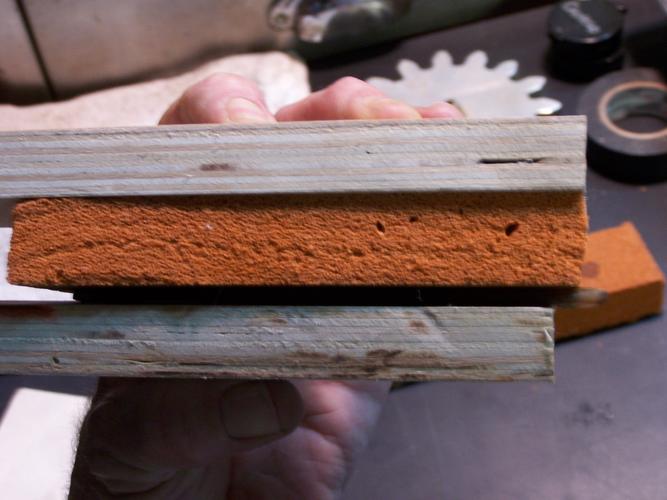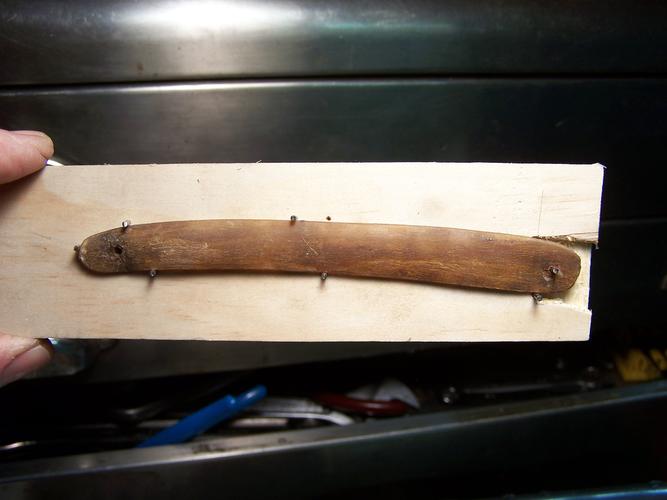Results 1 to 10 of 16
Hybrid View
-
02-03-2013, 05:22 PM #1

You could try,
- filling the crack with epoxy and using big washers
- scabbing in another piece of horn that spans the crack, something with a longish scarf
- filling the crack and lining the inside of the scale with a light wieght piece of fiberglass cloth wetted with epoxy.
I like the idea of letting in a piece of horn as a scab the best.
Charlie
- filling the crack with epoxy and using big washers
-
The Following 2 Users Say Thank You to spazola For This Useful Post:
10Pups (02-03-2013), cudarunner (02-12-2013)
-
02-03-2013, 05:31 PM #2Senior Member




- Join Date
- Nov 2012
- Location
- Across the street from Mickey Mouse in Calif.
- Posts
- 5,320
Thanked: 1184
I do want to play with the intention of saving. Thanks for the tips. The more I look at them the more they cry "save me". I like the challenge of impossible also. :<0)
If I want to do any adhesives later I am thinking water would be a better soak than oil ? Or use steam maybe ?Good judgment comes from experience, and experience....well that comes from poor judgment.
-
02-05-2013, 12:05 AM #3Senior Member




- Join Date
- Nov 2012
- Location
- Across the street from Mickey Mouse in Calif.
- Posts
- 5,320
Thanked: 1184 Let's see if they can be flattened first .
Let's see if they can be flattened first .
So. I started to play with them and the first thing I did was soak them in water for 6 hours. I took one out and put it between a rag and set it in the vice just to see what happens. It was very encouraging to see it dried and held a somewhat straighter shape. I tossed them back in the water and started gathering up some clamps and wood. I dug up an old pad for an English saddle I had and cut some pieces to make a wood/scale/foam sandwich.
This side was a lot thicker than the other half. These scales looked to me like they were one piece when they were first made.
I left the part hanging out the end because it's part of the wedge. I didn't want it to affect the flatness of the scale as it was pressed so I simply left it hanging out. Then I clamped it down as tight as I could with c- clamps. I did even it out on the end so it did not put too much pressure on the piece extending out.

The second half took some thinking. A crack at the hinge pin and the wedge end was thicker on this side than the other. Plus the wedge part was not at all even as it looked to me like it cracked or was pulled apart at one time. I wanted to try to force the crack closed and press it flat at the same time so I notched out a piece of the wood for it to hang in so I could use a nails to hold it in place. After I got the nails in I trimmed them down to the height of the scale with cutters.

The crack closed up pretty nice and I hope it stays that way. I can think of 2 mistakes I may have made. 1. I could have put some paper towels in the sandwich to help the scales dry out faster/better. 2. The wedge end of the second scale may bend down into the notch as I was not careful with the depth of it. So I have to go fix these things and in a couple of days I'll come back with what happened. So far I am feeling this may work out after all !Good judgment comes from experience, and experience....well that comes from poor judgment.
-
02-05-2013, 12:17 AM #4

Soaking them in water may prove to only be a temporary fix. They may start cracking again once they start drying out again. I agree with an earlier poster that some neatsfoot oil would be a worthwhile effort. I would like to compare that with getting a good moisturizer for your dry hands as opposed to just soaking them in water hoping that cracks and dry skin will go away because they get hydrated.
And whatever you do, let them dry very slowly. Maybe put them in the fridge or something.
-
The Following User Says Thank You to Storsven For This Useful Post:
10Pups (02-05-2013)
-
02-05-2013, 05:24 AM #5Senior Member




- Join Date
- Nov 2012
- Location
- Across the street from Mickey Mouse in Calif.
- Posts
- 5,320
Thanked: 1184
Point taken on the neatsfoot oil. I started with water in hopes of using an adhesive on some of the cracks first. Then I was thinking of using the neatsfoot oil after the scales dried and the glue set. I was also thinking put the oil on and put them back in the press for a week or so. I wonder if I should sand the scales smooth before putting the oil on. Then there is the matter of finish/sealing.
Good judgment comes from experience, and experience....well that comes from poor judgment.
-
02-05-2013, 11:24 AM #6

I found a link to working with horn that could be useful. Using and working with Horn - Making a Drinking Horn
-
The Following User Says Thank You to Storsven For This Useful Post:
10Pups (02-06-2013)
-
02-05-2013, 05:40 PM #7Senior Member



- Join Date
- Apr 2012
- Location
- Diamond Bar, CA
- Posts
- 6,553
Thanked: 3215
If you really want to save the originals, I like Charlie’s idea scarfing a piece on the pivot end and using a liner, Aluminum, Brass or Carbon fiber. I would use some Buffalo for contrast or color, kind of like a 55 -56 Belair.
-
The Following User Says Thank You to Euclid440 For This Useful Post:
10Pups (02-06-2013)
-
02-06-2013, 12:21 AM #8Senior Member




- Join Date
- Nov 2012
- Location
- Across the street from Mickey Mouse in Calif.
- Posts
- 5,320
Thanked: 1184
That is a cool article thanks.
" If you really want to save the originals, I like Charlie’s idea scarfing a piece on the pivot end "
I kinda get the idea of scarfing but not exactly sure how to go about that. What do I carve out a layer and cut a piece to fit in on both sides? The liner idea is formulating in my head and I thought about some bolsters over the ends also. Most of my metal work experience has been with BIG iron. Truck beds, tractors, 1/2" 3/4 " plate etc. This working under a magnifying glass is all new but very interesting :<0)Last edited by 10Pups; 02-06-2013 at 12:25 AM.
Good judgment comes from experience, and experience....well that comes from poor judgment.


 2Likes
2Likes LinkBack URL
LinkBack URL About LinkBacks
About LinkBacks






 Reply With Quote
Reply With Quote
